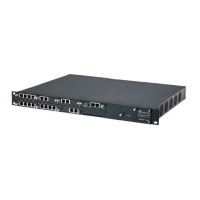Version 6.2 253 February 2011
SIP User's Manual 3. Web-Based Management
3.3.3.4.1 Configuring General QoS Settings
The General QoS item allows you to configure your WAN bandwidth.
¾ To configure the device's WAN bandwidth:
1. Click the General QoS item (Configuration tab > Data menu > QoS submenu >
General QoS); the following page appears:
Figure 3-161: Configuring General WAN Bandwidth
2. From the 'WAN Devices Bandwidth (Rx/Tx)' drop-down list, select the required Rx/Tx
bandwidth. If you do not see an appropriate entry, select 'User Defined', and then
enter your Tx and Rx bandwidths in the fields below:
• 'Rx Bandwidth': defines the device's Internet traffic receiving rate (in Kbps).
• 'Tx Bandwidth': defines the device's outbound transmission rate (in Kbps).
Notes:
• For correct QoS performance, ensure that the bandwidth values are
correct.
• For T1 WAN interface, the maximum Tx bandwidth per T1 physical link is
1.544 Mbps.
3.3.3.4.2 Configuring Matching Rules
Matching of packet rules allows you to manage and avoid traffic congestion by defining
inbound and outbound priority rules for each element on your device. These rules
determine the priority assigned to the packets traveling through the element. QoS
parameters (DSCP marking and packet priority) are set per packet on an application basis.
You can set QoS parameters using flexible rules, according to the following parameters:
Source/destination IP address, MAC address or host name
Device
Source/destination ports
Limit the rule for specific days and hours
The device supports two priority marking methods for packet prioritization:
DSCP (see ''Configuring DSCP Settings'' on page 260).
802.1p Pri
ority (see ''Configuring 802.1p Settings'' on page 262).

